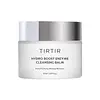What's inside
What's inside
 Key Ingredients
Key Ingredients

 Benefits
Benefits

 Concerns
Concerns

 Ingredients Side-by-side
Ingredients Side-by-side

Ethylhexyl Palmitate
EmollientPEG-20 Glyceryl Triisostearate
EmollientCetyl Ethylhexanoate
EmollientPEG-10 Isostearate
EmulsifyingSynthetic Wax
AbrasiveOryza Sativa Bran Oil
EmollientCaprylyl Glycol
EmollientTocopheryl Acetate
AntioxidantCamellia Sinensis Seed Oil
HumectantCamellia Japonica Seed Oil
EmollientSqualane
EmollientSimmondsia Chinensis Seed Oil
EmollientEthylhexylglycerin
Skin ConditioningWater
Skin ConditioningNiacinamide
SmoothingAllantoin
Skin ConditioningPanthenol
Skin ConditioningCamellia Sinensis Leaf Extract
AntimicrobialButylene Glycol
HumectantTocopherol
Antioxidant1,2-Hexanediol
Skin ConditioningHamamelis Virginiana Extract
AntiseborrhoeicBifida Ferment Filtrate
Skin ConditioningBifida Ferment Lysate
Skin ConditioningSaccharomyces Ferment Filtrate
HumectantLactobacillus Ferment Lysate
Skin ConditioningLactococcus Ferment Lysate
Skin ConditioningGlycyrrhiza Glabra Root Extract
BleachingCentella Asiatica Extract
CleansingOryza Sativa Extract
AbsorbentLavandula Angustifolia Extract
Skin ConditioningRosmarinus Officinalis Extract
AntimicrobialMonarda Didyma Leaf Extract
Skin ConditioningAnthemis Nobilis Flower Extract
MaskingJasminum Officinale Extract
MaskingProtease
ExfoliatingEthylhexyl Palmitate, PEG-20 Glyceryl Triisostearate, Cetyl Ethylhexanoate, PEG-10 Isostearate, Synthetic Wax, Oryza Sativa Bran Oil, Caprylyl Glycol, Tocopheryl Acetate, Camellia Sinensis Seed Oil, Camellia Japonica Seed Oil, Squalane, Simmondsia Chinensis Seed Oil, Ethylhexylglycerin, Water, Niacinamide, Allantoin, Panthenol, Camellia Sinensis Leaf Extract, Butylene Glycol, Tocopherol, 1,2-Hexanediol, Hamamelis Virginiana Extract, Bifida Ferment Filtrate, Bifida Ferment Lysate, Saccharomyces Ferment Filtrate, Lactobacillus Ferment Lysate, Lactococcus Ferment Lysate, Glycyrrhiza Glabra Root Extract, Centella Asiatica Extract, Oryza Sativa Extract, Lavandula Angustifolia Extract, Rosmarinus Officinalis Extract, Monarda Didyma Leaf Extract, Anthemis Nobilis Flower Extract, Jasminum Officinale Extract, Protease
Caprylic/Capric Triglyceride
MaskingC13-15 Alkane
SolventPEG-20 Glyceryl Triisostearate
EmollientSynthetic Wax
AbrasiveRicinus Communis Seed Oil
MaskingHelianthus Annuus Seed Oil
EmollientSilica Dimethyl Silylate
EmollientPolysorbate 85
EmulsifyingLithospermum Erythrorhizon Root Extract
Skin ConditioningPunica Granatum Fruit Extract
AntioxidantRibes Nigrum Fruit Extract
AstringentHippophae Rhamnoides Fruit Extract
Skin ConditioningFragaria Vesca Fruit Extract
AstringentMalpighia Emarginata Fruit Extract
Skin ConditioningEuterpe Oleracea Fruit Extract
Terminalia Ferdinandiana Fruit Extract
AntioxidantVaccinium Macrocarpon Fruit Powder
AntioxidantTrihydroxystearin
Skin ConditioningTocopheryl Acetate
AntioxidantZea Mays Germ Oil
EmollientPentaerythrityl Tetra-Di-T-Butyl Hydroxyhydrocinnamate
AntioxidantWater
Skin ConditioningButylene Glycol
HumectantCaprylic/Capric Triglyceride, C13-15 Alkane, PEG-20 Glyceryl Triisostearate, Synthetic Wax, Ricinus Communis Seed Oil, Helianthus Annuus Seed Oil, Silica Dimethyl Silylate, Polysorbate 85, Lithospermum Erythrorhizon Root Extract, Punica Granatum Fruit Extract, Ribes Nigrum Fruit Extract, Hippophae Rhamnoides Fruit Extract, Fragaria Vesca Fruit Extract, Malpighia Emarginata Fruit Extract, Euterpe Oleracea Fruit Extract, Terminalia Ferdinandiana Fruit Extract, Vaccinium Macrocarpon Fruit Powder, Trihydroxystearin, Tocopheryl Acetate, Zea Mays Germ Oil, Pentaerythrityl Tetra-Di-T-Butyl Hydroxyhydrocinnamate, Water, Butylene Glycol
 Reviews
Reviews

Ingredients Explained
These ingredients are found in both products.
Ingredients higher up in an ingredient list are typically present in a larger amount.
Butylene Glycol (or BG) is used within cosmetic products for a few different reasons:
Overall, Butylene Glycol is a safe and well-rounded ingredient that works well with other ingredients.
Though this ingredient works well with most skin types, some people with sensitive skin may experience a reaction such as allergic rashes, closed comedones, or itchiness.
Learn more about Butylene GlycolPeg-20 Glyceryl Triisostearate comes from Isostearic Acid and glycerin.
It is an emollient, emulsifier, and gentle cleanser. As an emollient, it helps trap moisture to keep skin soft and hydrated. Emulsifiers help prevent ingredients from separating.
This ingredient is common in oil-based products. This is because it helps oil-ingredients be easily washed away without leaving a residue.
Peg-20 Glyceryl Triisostearate may not be fungal-acne safe.
Learn more about PEG-20 Glyceryl TriisostearateSynthetic Wax is created from fossil fuels such as natural gas. It is used to enhance texture, adjust pH, and as an occlusive.
It may also be used as an abrasive ingredient to exfoliate the skin.
Synthetic Wax may not be fungal acne safe.
Learn more about Synthetic WaxTocopheryl Acetate is AKA Vitamin E. It is an antioxidant and protects your skin from free radicals. Free radicals damage the skin by breaking down collagen.
One study found using Tocopheryl Acetate with Vitamin C decreased the number of sunburned cells.
Tocopheryl Acetate is commonly found in both skincare and dietary supplements.
Learn more about Tocopheryl AcetateWater. It's the most common cosmetic ingredient of all. You'll usually see it at the top of ingredient lists, meaning that it makes up the largest part of the product.
So why is it so popular? Water most often acts as a solvent - this means that it helps dissolve other ingredients into the formulation.
You'll also recognize water as that liquid we all need to stay alive. If you see this, drink a glass of water. Stay hydrated!
Learn more about Water